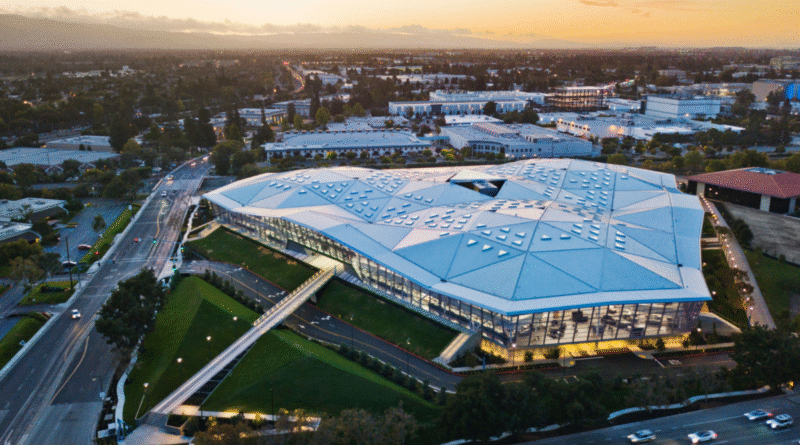Nvidia Corporation Hits a Historic $5 Trillion Valuation
On October 29, 2025, Nvidia Corporation (NASDAQ: NVDA) made history as the first publicly traded company to surpass a $5 trillion market capitalization, according to reports from Reuters and Financial Times.
This landmark moment marks a meteoric rise for the Silicon Valley chip giant, whose market value has more than doubled in less than a year — fueled by the global explosion in artificial intelligence (AI) demand and its unmatched dominance in AI chip manufacturing.
“Nvidia’s valuation now exceeds the GDP of major economies like Japan and India,” reported TFM, underlining the scale of investor optimism surrounding the AI revolution.
What’s Driving Nvidia’s Unprecedented Growth
1. Surging AI Chip Demand
- Nvidia’s GPUs and specialized AI chips power nearly every major AI model and cloud platform — including ChatGPT, Gemini, and Anthropic’s Claude.
- The company reported over $500 billion in upcoming chip bookings, according to Reuters, setting the stage for another record fiscal year.
- Nvidia controls over 80 % of the global GPU market for AI training and inference.
Its next-generation Blackwell architecture chips are expected to outperform competitors by 30–40 %, strengthening its leadership in AI data centers and autonomous systems.
2. Strategic Partnerships Expanding Nvidia’s Reach
Uber Robotaxi Alliance
In a move signaling Nvidia’s expansion beyond chips, the company partnered with Uber Technologies to develop next-gen autonomous ride-hailing (robotaxi) systems using Nvidia DRIVE platforms.
This partnership integrates Nvidia’s AI software stack into Uber’s self-driving operations — setting up a multi-billion-dollar future mobility ecosystem.
$1 Billion Investment in Nokia for 6G
Nvidia also announced a $1 billion investment in Nokia Corporation to co-develop AI-native 6G telecom infrastructure.
The goal: create networks that can self-optimize, process data at the edge, and serve as the backbone for future smart cities and IoT expansion.
US Department of Energy Supercomputers
The company plans to build seven AI supercomputers for the U.S. Department of Energy — part of the U.S. national AI infrastructure initiative.
This reinforces Nvidia’s growing role as a global infrastructure provider, not merely a chip manufacturer.
Key Data Points
| Metric | Details (as of Oct 2025) |
|---|---|
| Market Cap | $5.03 trillion |
| AI Chip Bookings | ≈ $500 billion |
| GPU Market Share | > 80 % globally |
| Major Partnerships | Uber, Nokia, DOE |
| Annual Revenue (FY 2025 est.) | ≈ $140 billion |
| CEO Net Worth | Jensen Huang – $180 billion (Times of India) |
Why This Milestone Matters
- Redefining AI Infrastructure: Nvidia now anchors the global AI ecosystem — powering data centers, LLMs, autonomous vehicles, and telecom systems.
- Investor Confidence: A $5 trillion valuation signals that AI hardware is now viewed as the “new oil” of the digital economy.
- Ecosystem Expansion: Nvidia’s reach across AI, mobility, and telecommunications shows its strategy to own the full stack of future technology infrastructure.
- Geopolitical Impact: With U.S.–China tech tensions ongoing, Nvidia’s role in chip supply and AI dominance has significant strategic implications.
Risks to Watch
Despite historic highs, analysts warn of several potential headwinds:
- Valuation Overheating: At $5 trillion, market expectations are extremely high — any slowdown in AI growth could trigger corrections.
- Export Restrictions: Ongoing U.S. export bans to China could limit Nvidia’s near-term revenue in Asian markets.
- Rising Competition: AMD, Intel, and new entrants like Tenstorrent are scaling up AI chip capabilities.
- Execution Risk: Turning $500 billion in bookings into sustained revenue and profit is a major operational challenge.
Future Outlook (2026 – 2028)
| Focus Area | Nvidia’s Strategic Direction |
|---|---|
| Next-Gen Chips | Mass deployment of Blackwell and Rubin AI architectures. |
| Telecom & 6G | Expansion through Nokia partnership and AI-native base stations. |
| Mobility AI | Large-scale rollout of robotaxis with Uber and other partners. |
| Global AI Data Centers | New AI supercomputers across North America, Europe, and Asia. |
| AI Software Ecosystem | Growth of CUDA, DGX Cloud, and Omniverse for enterprise AI use. |
Industry analysts forecast Nvidia could reach $6 trillion valuation by mid-2026, assuming strong AI demand and sustained leadership in GPU innovation.
Impact on Indian Market and Startups
For Indian investors and entrepreneurs, Nvidia’s growth story carries powerful lessons:
- AI Infrastructure Boom: India’s data center and AI chip integration market is projected to grow by 30 % CAGR through 2030.
- Startup Opportunities: Companies working on AI model optimization, data management, or telecom hardware can integrate Nvidia’s stack to accelerate scalability.
- Investment Signals: Global funds are shifting toward AI-driven infrastructure — a trend that Indian tech firms can capitalize on through partnerships or OEM supply roles.
Conclusion
Nvidia’s $5 trillion valuation isn’t just a corporate milestone — it’s a symbol of the AI economy’s rise.
From powering autonomous vehicles to enabling next-gen telecom systems, Nvidia has transformed into the backbone of global digital infrastructure.
Yet, the journey ahead demands flawless execution, geopolitical navigation, and innovation at scale.
For investors, startups, and policymakers alike, Nvidia’s ascent signals a new industrial paradigm — where AI hardware defines the next era of global growth.
Keep Reading:
- Sony paid $3.6B for Bungie in 2022, but what if it had just invested instead of acquiring?
- Taiwan’s Foxconn to Invest Up to $1.4 Billion in AI Data-Center Equipment — What it Means
- Billionaire Kwek Leng Beng’s CDL Sells 84% of Zyon Grand Towers as Singapore Market Heats Up
- Comet vs Google Chrome: Which Browser Wins in 2025?
- Tata Capital IPO 2025: To Raise $1.7 Billion in India’s Biggest Listing of the Year




